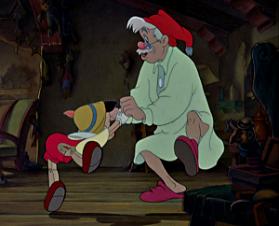When You Wish Upon A Star: The Musical Making of Walt Disney’s Pinocchio
by Jeremie | March 10, 2009 2:06 pm
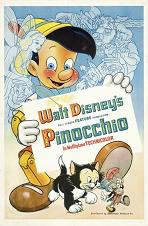 For Pinocchio, Walt Disney showed no small ambition: he wanted it to be the most wonderful animated film ever created – and he would spare no expense to achieve it.
For Pinocchio, Walt Disney showed no small ambition: he wanted it to be the most wonderful animated film ever created – and he would spare no expense to achieve it.
De facto, the production of his second full-length feature animated film started immediately after Snow White as a new step forward towards beauty and innovation.
Indeed, because of its very content, the story of Pinocchio offers a much wider range of possibilities than Snow White. Confined almost exclusively in two places – the castle and the cottage – the whole storyline of Walt’s first feature converged towards the Dwarfs’ house to better bring out its warmth and all the endeavors made to try and protect it.
Pinocchio presents a much larger palette of situations, plots and subplots, because of extremely different locations (the small village, the theater, Pleasure Island, the submarine expedition), and secondary characters such as Figaro, Cleo, “Honest” John, Giddeon, Stromboli, the Coachman and Lampwick.
That said, the definition of any of Walt Disney’s animated classics is the extraordinary coherence – and complementing – of the story, the visuals and the music. And Pinocchio is far beyond being an exception to the rule. It is even more a precursor. As well as this narrative complexity, the music is of particularly great assistence in understanding the true meaning of the film as a whole.

Musical Character(s)
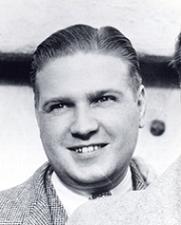 As with any aspect of the film, Pinocchio‘s music is a team effort: Paul J. Smith helped to shape out the score whereas Edward Plumb, Frederick Stark, Charles Wolcott worked mostly on the orchestrations. Yet, Leigh Harline’s personality stands out the most [right] and was the recipient of the two Academy Awards presented for the music of Pinocchio. A wonder of both poetry and virtuosity, the fact is that this score does not originate in the theatre as Frank Churchill’s for Snow White, but truly in the classical training of its creators. For instance, Harline majored in music at the University of Utah and studied piano and organ with former director of the Mormon Tabernacle Choir J. Spencer Cornwall. No suprise, then, to retrieve in that score musical traits borrowed from the classical repertoire.
As with any aspect of the film, Pinocchio‘s music is a team effort: Paul J. Smith helped to shape out the score whereas Edward Plumb, Frederick Stark, Charles Wolcott worked mostly on the orchestrations. Yet, Leigh Harline’s personality stands out the most [right] and was the recipient of the two Academy Awards presented for the music of Pinocchio. A wonder of both poetry and virtuosity, the fact is that this score does not originate in the theatre as Frank Churchill’s for Snow White, but truly in the classical training of its creators. For instance, Harline majored in music at the University of Utah and studied piano and organ with former director of the Mormon Tabernacle Choir J. Spencer Cornwall. No suprise, then, to retrieve in that score musical traits borrowed from the classical repertoire.
The first great musical innovation of Pinocchio is in its extensive use of the Leitmotive Technique in the history of animation. Richard Wagner’s device consists in associating characters or concepts to themes that recur all along the story, tailored to the situations and the emotions – a technique first used in live-action films by composers like Max Steiner, Erich Korngold or Frank Waxman in the 30s. Through Leitmotives, the interiority of a character or the evolution of an idea can be particularized at its closest. That was embryonic in Snow White, through the recurring use of One Song symbolizing Snow White and her Prince’s love, or of Dopey’s theme, but it was not systematic and the term Leitmotiv can’t really be used until Pinocchio.
Consider the first act of the film: the score is just made out of almost all the themes (mostly main characters’ themes) that are to be developed all throug the movie:
Little Wooden Head (Pinocchio)
Old Gepetto (Gepetto)
Fairy Theme (the Blue Fairy)
Crickey Theme (Jiminy)
Kitten Theme (Figaro & Cleo)
When You Wish Upon a Star (hope and morals –Jiminy and the Blue Fairy)
Turn on the Old Music Box (simple joy – Gepetto and Pinocchio)
As composer Paul J. Smith explained it in Etude Music Magazine, “the songs are the first basis of the complete score. We like to use them as Leitmotives, to suggest both characters and situations throughout the picture. Take, for instance, the little theme with the hoppity-hop rhythm that symbolizes Jiminy Cricket. It is stated as the Cricket’s tune, and appears as the inner voice of a more important theme, or merely as a rhythmic suggestion, in every scene in which Jiminy is about to assume the center of the stage. The star song is sung but twice in the picture, but it appears (in free variations, parallel chords, and so on) in every sequence where Jiminy and the Fairy combine their power in working out Pinocchio’s destiny. The development of these variations of the theme requires the most detailed care. The spectator must be aware of the theme and of its slightly altered form, but neither theme nor variation may at any time rise to the point of occupying his conscious attention.”
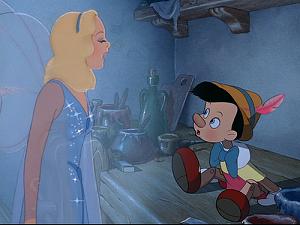
In animation, each character has its own artistic supervisor, their own way of moving and expressing. Now, through music, each character has its own way of feeling. Without Leitmotiv, music can depict sadness in general, or any other feeling, yet it does not really participate in the scene. Through a theme, focus is now set on one definite character, which really helps read the scene a more accurate way, especially when many characters are involved at the same time in a shot. Consequently, the film is easier to comprehend and to be involved in; it gets more pleasant and more moving. Thus, if the theme of the Blue Fairy experiences no modification (she symbolizes something eternal and unalterable, something of divine provenance), Pinocchio’s theme varies the most, according to the situations. For example, from major key in the introductory sequence, it turns into a minor key in Sad Reunion, and mostly in Message from the Blue Fairy, with a tragic unfolding that Jiminy’s hopitty-hop rhythm helplessly tries to alleviate.
Each one of these themes (to which Honest John’s Hi-Deedle-Dee-Dee has to be added) occurs several times in the film, ensuring the togetherness of the whole: the story of Pinocchio is actually a series of episodes, with not much connection between them (Stromboli on one side, Pleasure Island on the other, to end with the episode of Monstro the Whale). It is the coherence of the music, the finding of the same themes in each episode, that gives the film its unity. The process allows to imprint a strong identity to the whole film from the sonorous viewpoint, to create a musical universe of its own, easily recognizable, the same way artistic directors create a characteristic, visual universe. Through the impregnation of these themes in the audience’s mind and heart, it allowes to make the world of the film and its values even more pregnant and reachable.
After Pinocchio, this technique is to be abundantly resumed in the Disney films to follow, and with further developments, from composers such as Oliver Wallace to Alan Menken. But that’s another story…
Musical Effects
 If the music complements the story in terms of the characters, it can also act as a counterpart to the visual effects, for the most unexpected of…effects! Indeed, Pinocchio offers the most stunning visual effects since Snow White, that help put the emphasis on certain key elements or key moments.
If the music complements the story in terms of the characters, it can also act as a counterpart to the visual effects, for the most unexpected of…effects! Indeed, Pinocchio offers the most stunning visual effects since Snow White, that help put the emphasis on certain key elements or key moments.
Thus, the opening shot of the village deserves in itself all our consideration. From the Wishing Star to Gepetto’s Workshop, it is completely shot with the famous Multiplane Camera, that is to be used in an even more complex way for the sequence of the town coming to life the following morning, with twelve levels of depth that grasp at random, simple moments of the people’s everyday life.
The other most stunning effects come at the end of the movie, during the submarine and maritime episodes, when Pinocchio plunges to search for his father and then runs from Monstro – the climax of the film.
But the value of all those astonishing and then state-of-the-art effects (perhaps even more impressive today) does not only lay on the technical or make-believe aspect of them. In fact, they’re really part of the substance of the film. Through those two shots of the village, simple life is promoted – a life of hopes, since the village is connected to the Star and bathes in its brilliance.
About the maritime sequence, it had to stand out visually since, along with Pinocchio and his friends, we are faced with the very villain of the story. Honest John, Giddeon, Stromboli and the Coachman were just means to make Pinocchio question his attitude, help him be aware of the necessity of being a good boy. When Pinocchio goes and looks for his father, it is from a totally different perspective; Pinocchio is not the same person and the audience’s hopes totally rest upon him – hopes that are all the higher since the danger is high, taking place in the most unusual and extraordinary of surroundings for an animated cartoon.

What results from that is the remarkable structure of the movie. Despite the very episodic nature of the story, reminiscent – even though simplified – of Collodi’s original narrative, an arc seems to appear, linking the two moments that demand the biggest efforts in terms of technical improvement and art direction. That arc is not extraordinary when you think about traditional narrative structure, but, interestingly enough, it links art to technology (Multiplane, watery effects), and metaphorically, it evokes an association typical of Walt Disney between the values of the Old World and the ones of the New World. Whereas the climax of the film is based on the figure of the American little guy fighting the odds – in a kind of a David vs Goliath setting – nothing is spared, at the beginning of the movie, to praise and emphasize humility and humanity at is plainest and warmest, enhancing the delicate designs by European illustrator Gustaf Tenggren.
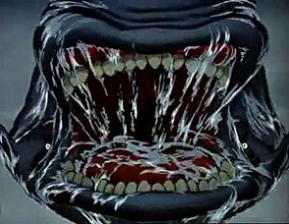 This same emphasis can again be seen in the musical setting of these two moments, which demanded the greatest attention and skills from the composers, the classical way. More than a sonorous ornament that sets the atmosphere according to the picture, the end of the movie is a very well organized symphonic work, with genuine developments (Monstro Awakens), astonishing timbres (Deep Ripples) and a strong emotional core (Desolating Theme). And the Whale Chase episode confirms that, through it violent rhythms and wild orchestrations, that required the joined efforts of both Harline and Edward Plumb, a former student of Johnan Strauss’ (who later did the impressive fire sequence in Bambi).
This same emphasis can again be seen in the musical setting of these two moments, which demanded the greatest attention and skills from the composers, the classical way. More than a sonorous ornament that sets the atmosphere according to the picture, the end of the movie is a very well organized symphonic work, with genuine developments (Monstro Awakens), astonishing timbres (Deep Ripples) and a strong emotional core (Desolating Theme). And the Whale Chase episode confirms that, through it violent rhythms and wild orchestrations, that required the joined efforts of both Harline and Edward Plumb, a former student of Johnan Strauss’ (who later did the impressive fire sequence in Bambi).
So, plenty of effects, both visual and musical, yet never purposeless. Everything, from the stunning pictures to the excitment of the music, contributes to create a stricking contrast with the last scene: the transformation of Pinocchio into a real boy. That’s no big finale like at the end of Snow White, but rather the return to the village at the sound of the Turn on the Old Music Box theme, which we had discovered at the beginning at the film.
Which leads us back to that very beginning of the movie, that long scene of introduction of the main characters that stands out even more now since it holds the key to the understanding of the film as a whole and its true meaning. For Walt Disney, that was the most important feature of his film. Besides, six months after the beginning of the production, he stopped everything. He was not satisfied with the original project and wanted to start over again. That’s how unforgettable, secondary characters like Figaro and Cleo came along to enhance Pinocchio, Jiminy and Gepetto’s natural charm.
The emotionally comfortable sound of that first scene comes from the European, Old World flavor of Harline’s score. We all remember the sound of the little music boxes of Gepetto’s Workshop, expressing all the charm and happiness of simple life, the resound joyfully for Pinocchio’s birth in Turn On the Old Music Box. In fact, it was the Studio’s sound effects men, who were at the same time true musicians, who played themselves this wonderful tune, in order to give it both a mechanical character through the sounds used, and a very musical and dancing character that a real music box could not have conveyed so well.
We can also hear that kind of magical blending of glockenspiel, concertina and string pizzicati in the Clock Sequence cue. Harline also succeeded in conveying this atmosphere through his inspiration from popular, tradition European tunes (some, like Churchill, did it in The Dwarfs’ Yodel Song for Snow White). These melodies are Little Wooden Head, Old Gepetto and I’ve Got No Strings. The harmony is elementary and the melodies are very catchy, which gives this very simple character a kind of a nostalgic flavour by going back to the roots of Western music.
Ukulele Jiminy
But Pinocchio is no backward-looking film. On the contrary, it is truly optimistic and always looking to the future. And this unique dimension is brought by nothing else than the music. The key here is Jiminy Cricket, whom Walt Disney decided to be Pinocchio’s conscience, “the Lord Keeper of the Knowledge of Right and Wrong”, when he started the film over again. His character is held exactly between Gepetto’s, Honest John’s and the Blue Fairy’s worlds; he is the link between the everyday life and the supernatural. The two most important songs of the film are his: Give a Little Whistle and, most of all, When You Wish Upon a Star – both American songs, because of their style, inspired by jazz. Give a Little Whistle is very up-tempo, with a swing touch to it, guitar, bass and drum, and mute trumpet, whereas When You Wish Upon A Star hangs for the most part on vocalist Cliff Edwards’ performance.
Walt Disney did not settle for an operatic voice for this main title (as he did, for instance, for the Prince, Harry Stockwell, in Snow White), but rather to a singer of the 20s, well-known as “Ukulele Ike”, who used to brilliantly sing jazz songs (he also voiced Jim Crow in Dumbo). So, with Walt Disney wanting a jazz singer for Pinocchio, Jiminy sings typically American songs, with a typically American style (of the time), where all the elements converge to the heights, to the Star: the pitch of the singer, the melodic line (ascendant ninths), and the lyrics, emphasizing the fact that honesty is the only richness that is worth in the fullfilment of dreams. An approach that echoes the speech Walt Disney delivered to the New York Opera on March 1st 1942, entitled Our American Culture. In that speech, he stands as a staunch patriot living in a country ruled by democracy and where culture is at everybody’s reach. He also stresses the relationship between moral and arts (particularly his own, animation), talking about “a true and honest culture”, to better laud “tolerance, democracy and freedom [that] make every American stand up and cheer for our American way of life”.

In that way, Pinocchio blends the best part of Europe and the best part of America, in order to promote a unique vision of modernity, at the opposite of positivism, where progress is not in the making a clean sweep of the past, in a forgetting of the past, or a getting rid of it. On the contrary, through his brilliant composers, Disney presents us with a humanistic vision of progress, a progress that knows where it comes from and where it goes. Pinocchio can only reach humanity and begin a new and honest life when he understands where he comes from – Gepetto, Figaro and Cleo – and their importance. Then, Pinocchio is no more a victim (of “Honest” John, or of the Coachman) and takes hold of his life, his destiny in order to change things, and improve them (which then makes him a true American character).
Hence the association, in the closing sequence cue Real Boy, of Turn On the Old Music Box and When You Wish Upon a Star: a unique blending of tradition and modernity, a subtle balance that makes all the Disney magic – and our dreams – come true!
The
Pinocchio Platinum Edition is available
to buy on Blu-ray Disc now from Amazon.com

 [1]
[1]
Endnotes:- [Image]: http://www.amazon.com/exec/obidos/ASIN/B001ILFUDM/animatedviews-20
Source URL: https://animatedviews.com/2009/wish-upon-a-star-the-making-of-pinocchio/
Copyright ©2024 Animated Views unless otherwise noted.
 For Pinocchio, Walt Disney showed no small ambition: he wanted it to be the most wonderful animated film ever created – and he would spare no expense to achieve it.
For Pinocchio, Walt Disney showed no small ambition: he wanted it to be the most wonderful animated film ever created – and he would spare no expense to achieve it.
 As with any aspect of the film, Pinocchio‘s music is a team effort: Paul J. Smith helped to shape out the score whereas Edward Plumb, Frederick Stark, Charles Wolcott worked mostly on the orchestrations. Yet, Leigh Harline’s personality stands out the most [right] and was the recipient of the two Academy Awards presented for the music of Pinocchio. A wonder of both poetry and virtuosity, the fact is that this score does not originate in the theatre as Frank Churchill’s for Snow White, but truly in the classical training of its creators. For instance, Harline majored in music at the University of Utah and studied piano and organ with former director of the Mormon Tabernacle Choir J. Spencer Cornwall. No suprise, then, to retrieve in that score musical traits borrowed from the classical repertoire.
As with any aspect of the film, Pinocchio‘s music is a team effort: Paul J. Smith helped to shape out the score whereas Edward Plumb, Frederick Stark, Charles Wolcott worked mostly on the orchestrations. Yet, Leigh Harline’s personality stands out the most [right] and was the recipient of the two Academy Awards presented for the music of Pinocchio. A wonder of both poetry and virtuosity, the fact is that this score does not originate in the theatre as Frank Churchill’s for Snow White, but truly in the classical training of its creators. For instance, Harline majored in music at the University of Utah and studied piano and organ with former director of the Mormon Tabernacle Choir J. Spencer Cornwall. No suprise, then, to retrieve in that score musical traits borrowed from the classical repertoire.

 If the music complements the story in terms of the characters, it can also act as a counterpart to the visual effects, for the most unexpected of…effects! Indeed, Pinocchio offers the most stunning visual effects since Snow White, that help put the emphasis on certain key elements or key moments.
If the music complements the story in terms of the characters, it can also act as a counterpart to the visual effects, for the most unexpected of…effects! Indeed, Pinocchio offers the most stunning visual effects since Snow White, that help put the emphasis on certain key elements or key moments.
 This same emphasis can again be seen in the musical setting of these two moments, which demanded the greatest attention and skills from the composers, the classical way. More than a sonorous ornament that sets the atmosphere according to the picture, the end of the movie is a very well organized symphonic work, with genuine developments (Monstro Awakens), astonishing timbres (Deep Ripples) and a strong emotional core (Desolating Theme). And the Whale Chase episode confirms that, through it violent rhythms and wild orchestrations, that required the joined efforts of both Harline and Edward Plumb, a former student of Johnan Strauss’ (who later did the impressive fire sequence in Bambi).
This same emphasis can again be seen in the musical setting of these two moments, which demanded the greatest attention and skills from the composers, the classical way. More than a sonorous ornament that sets the atmosphere according to the picture, the end of the movie is a very well organized symphonic work, with genuine developments (Monstro Awakens), astonishing timbres (Deep Ripples) and a strong emotional core (Desolating Theme). And the Whale Chase episode confirms that, through it violent rhythms and wild orchestrations, that required the joined efforts of both Harline and Edward Plumb, a former student of Johnan Strauss’ (who later did the impressive fire sequence in Bambi).